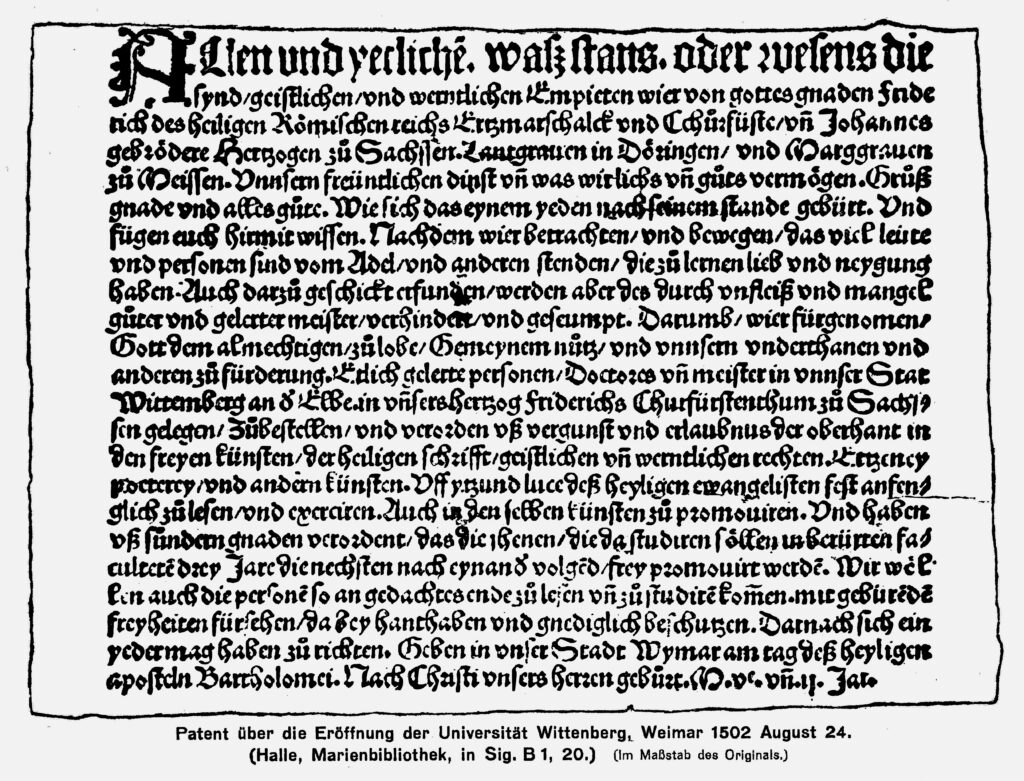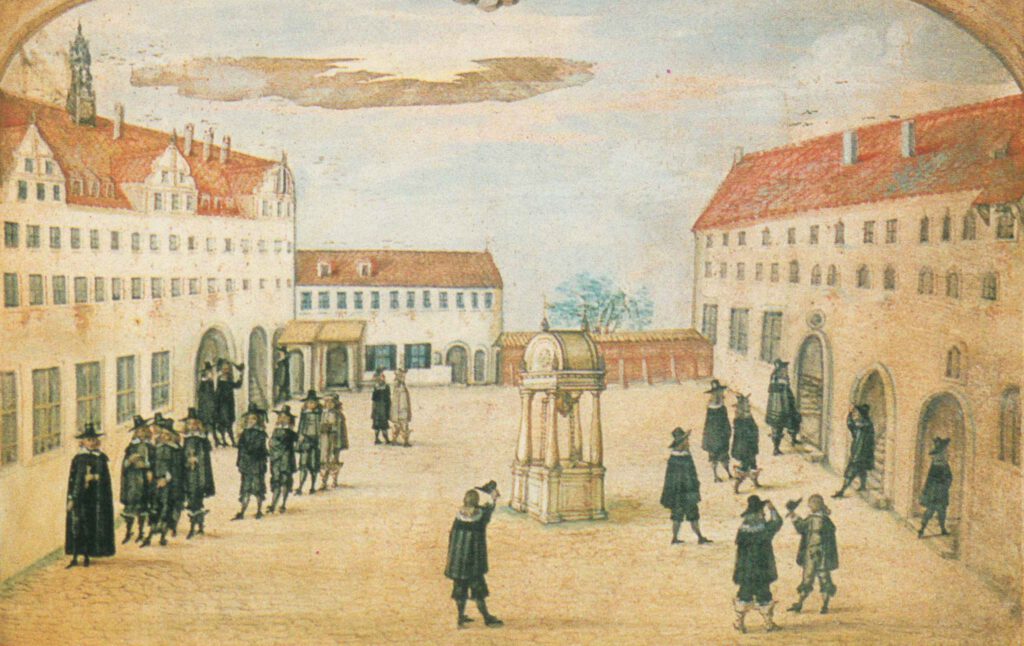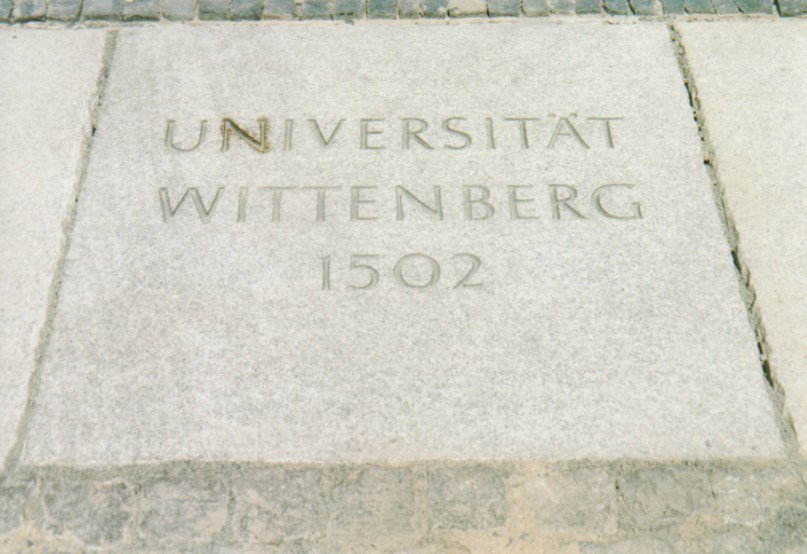Ever since the Internet came into existence, every institution that is worth something has its own website. Those who do not have one basically do not exist – or rather did not exist – in the general public perception. The University of Wittenberg ceased to exist in 1817, and thus it did not exist virtually until now. This marginalizes it, despite its importance, in cultural memory. To remedy this, the LEUCOREA is now being brought online here.
The University of Wittenberg LEUCOREA was founded in 1502 and was dissolved in 1817 by union with the University of Halle (founded in 1694). In the years of its existence the LEUCOREA had completed an eventful life. From 1520 to 1580 and 1605 to 1615 the LEUCOREA was the most frequented German university, experienced in the 17th and 18th century success as well as downturn phases and was around the turn of the century 1800 again on a way of the internal and external consolidation. As a result of the Napoleonic occupation of Wittenberg, the university effectively ceased its operations in 1813. The unification with Halle in 1817 then made the LEUCOREA part of the so-called great university death around 1800: 18 of the 34 German universities were closed during this time.
The website is structured similarly to the online presences of today’s existing universities. It therefore simulates the situation as if the Internet had already existed in 1817. However, it is now possible to fall back on the now extensive efforts to make historical sources and historiographic literature digitally available: For these, as far as they concern the LEUCOREA, the website is conceived as a hub leading to the digitized holdings. Wherever possible, the source and text references are therefore linked to full-text files or other supplementary information.

The website fulfills two functions: it is a sorted archive and a digital reading book. As a sorted archive, it provides orientation in the hardly manageable text holdings that exist from and about the University of Wittenberg. The materials are structured both by person and by subject. In this way, lines of sight are drawn through the abundance of material. The website can be used as a digital reading book to delve into the three centuries of the LEUCOREA and their afterlife. Texts by contemporary chroniclers convey factual information as well as the fluidity of the respective time. Historical documents prove what is often told and written correctly, sometimes half-true and sometimes wrong. Scientific texts that have been written on LEUCOREA since the 19th century provide knowledge on the current state of research. All independent publications are provided with abstracts. The main texts of the website sections are also offered in English versions.
Life continues even after a university closure. Therefore, this site also presents what took place in the field of science and higher education in Wittenberg after 1817 and what is happening there today, a good 200 years later. This, in turn, also shows intensive references to Wittenberg’s university history: The Evangelical Seminary of Preaching was founded in 1817 as a compensatory gift for the closed university, and until 2012 it was located in the former rectorate building of the LEUCOREA, the Collegium Augusteum, had taken over a large part of the university library and ensured the continuity of theological education in Wittenberg. The Luther Hall or the Luther Memorials Foundation operated and still operates the residence of the most famous professor of the university, as well as the former scholarship holders‘ house and, since 2012, the Collegium Augusteum. The Luther Society would not have been founded in Wittenberg in 1918 and returned in 2004 if Wittenberg had not been the city of the Reformation University. The Leucorea Foundation, together with the Collegium Fridericianum, operates the area where the major part of university life took place. The Research Library for the History of the Reformation secures and processes the tradition of the university that had remained in Wittenberg.

The website leads to over 750 full-text files: digitized original sources, research literature and popular images. These can be used to explore the 300 years of university development and the more than 200 years after university. A further nearly 250 linked PDF files contain supplementary information on titles that are not (yet) available online (tables of contents, reading samples and the like). The independent publications are also provided with abstracts. Since considerable holdings of original sources, especially autographs, are now available online, the website also links to 37 relevant archive portals or individual holdings within them. The editors are happy to receive information about web resources that have not yet been considered.
The website provides LEUCOREA with an online afterlife that bundles typical information about a university, web resources and specially created digital copies. Thus, with some delay, the unfortunate circumstance can be remedied that Wittenberg University, from the perspective of the Internet age, was abolished 180 years too early.
***
Thanks are due to a number of libraries, archives, portal operators and publishers for digitization activities, granted permission for subsequent use or the provision of information or image files, namely Akademie der Wissenschaften zu Göttingen, Archiv der Stadtkirchengemeinde Wittenberg, Bibliothek für Bildungsgeschichtliche Forschung Berlin, BWV Berliner Wissenschaftsverlag, Deutsche Digitale Bibliothek, Deutsche Nationalbibliothek, Digitale Bibliothek Mecklenburg-Vorpommern, Drei Kastanien Verlag Wittenberg, Evangelische Akademie Sachsen-Anhalt, Evangelische Verlagsanstalt, Evangelisches Predigerseminar Wittenberg, Google Books, Herzog August Bibliothek Wolfenbüttel, Internet Archive (San Francisco), JSTOR/ITHAKA Harbors Inc. (New York), Kreisarchiv Wittenberg, Landesarchiv Sachsen-Anhalt, Landesarchiv Thüringen, Library of Congress, Lukas Verlag, Luthergesellschaft, Peter Lang Verlag, Reclam Verlag, Reformationsgeschichtliche Forschungsbibliothek Wittenberg, Sächsische Landes- und Universitätsbibliothek, Sächsisches Staatsarchiv, Torsten Schleese (Wittenberg), SKW Stickstoffwerke Piesteritz, Staatsbibliothek Berlin, Städtische Sammlungen Wittenberg, Stiftung Luthergedenkstätten in Sachsen-Anhalt, SUB Göttinger Digitalisierungszentrum, Thüringer Universitäts- und Landesbibliothek Jena, Universitätsarchiv Halle, Universitätsarchiv Jena, Universitätsbibliothek Bielefeld, Universitätsbibliothek Heidelberg, Universitätsbibliothek Tübingen, Universitäts- und Landesbibliothek Sachsen-Anhalt, Verlag Karl Heinrich Bock, Verlag oekom, Wikipedia, Württembergische Landesbibliothek Stuttgart
The Institute for Higher Education Research (HoF) has been involved in the preparation of the website: Uwe Grelak, Stefan Haunstein, Daniel Hechler, Kerstin Martin, Sandy Menzel, Rebecca Reichert and Steffen Zierold. The editorial coordination and research work was done by Peer Pasternack and Daniel Watermann. Justus Henke was responsible for the web design and David Johst for the content management.
For the development of the website structure and the writing of the introductory texts for the menu items, reading the following works was particularly helpful: Walter Friedensburg: Geschichte der Universität Wittenberg, Halle (Saale) 1917 | Martin Treu/Ralf-Torsten Speler/Alfred Schellenberger: Leucorea. Bilder zur Geschichte der Universität, Lutherstadt Wittenberg 1999 | Heiner Lück/Enno Bünz/Leonard Helten/Armin Kohnle/Dorothée Sack/Hans-Georg Stephan (Ed.): Das ernestinische Wittenberg. Die Leucorea und ihre Räume, Petersberg 2017 – Table of Contents | Heiner Lück: Alma Leucorea. A History of the University of Wittenberg 1502 to 1817, Halle (Saale) 2020 – Table of Contents
Accompanying booklet
Peer Pasternack/Daniel Watermann: www.uni-wittenberg.de. Begleitheft zur Website, Institut für Hochschulforschung (HoF), Halle-Wittenberg 2020, 28 pp.

